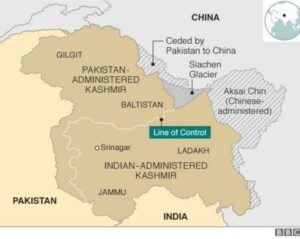In News
It was the 1971 war between India and Pakistan over the question of Bangladesh that turned the ceasefire line into the Line of Control (LoC), as it is known today. There was no LoC before 1972 Shimla Agreement was signed between India and Pakistan. This agreement also practically junked the UN resolution as the two countries agreed to resolve all disputes through bilateral talks.
History of Line of Control
- India’s response to Pakistani intrusion in 1947 resulted in a war that was declared over in 1949 with the United Nations intervening and accepting that the merger of Jammu and Kashmir with India was legal.
- A ceasefire line (CFL) was drawn depending on the actual positions held by the two armies — led on both sides by British generals.
- The ceasefire line temporarily bifurcated Jammu and Kashmir with India getting control of about 65% of the state and Pakistan the rest 35%.
- The ceasefire line was to begin from a point at Manawar — south of Chenab river — in Jammu and move northward till Keran. And, from Keran, the ceasefire line was to run northward till last then recognisable point known as NJ9842 and follow the mountain crestline further north up to the international border with China.
- The ceasefire line was formalised in a Karachi Agreement signed in July 1949 between India and Pakistan with two UN observers signing as witnesses.
- The sanctity of the ceasefire line was to be maintained till the final settlement of the Jammu and Kashmir issue. However, two incidents altered the status quo in Jammu and Kashmir during the 1960s — the India-China War of 1962 and India-Pakistan War of 1965.
Present Status
- China humbled India in the 1962 war and captured nearly 20% of the princely state. This area is called Aksai Chin and China denies India’s sovereignty over the cold desert region.
- Further in 1963, Pakistan signed an agreement with China and handed over about 2,000 sq miles area in northern Kashmir to China, which has held all of that since then.
- The Line of Control, thus drawn, gave Pakistan control over Pakistan-occupied Kashmir and Gilgit-Baltistan, which Pakistan has since declared the Northern Areas and rules directly. Rest of Jammu and Kashmir minus Aksai Chin is situated on the Indian side of Line of Control.
- The existing Line of Control runs from Manawar in Jammu to Indira Col on the tri-junction in Karakoram mountain range. The Indian and Pakistani troops have to maintain a no-man’s land of 500 yards on each side of the Line of Control.

















